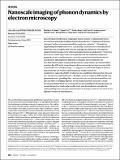| dc.contributor.author | Gadre, Chaitanya A. | |
| dc.contributor.author | Yan, Xingxu | |
| dc.contributor.author | Song, Qichen | |
| dc.contributor.author | Li, Jie | |
| dc.contributor.author | Gu, Lei | |
| dc.contributor.author | Huyan, Huaixun | |
| dc.contributor.author | Aoki, Toshihiro | |
| dc.contributor.author | Lee, Sheng-Wei | |
| dc.contributor.author | Chen, Gang | |
| dc.contributor.author | Wu, Ruqian | |
| dc.contributor.author | Pan, Xiaoqing | |
| dc.date.accessioned | 2022-06-10T14:12:56Z | |
| dc.date.available | 2022-06-10T14:12:56Z | |
| dc.date.issued | 2022-06-08 | |
| dc.identifier.issn | 0028-0836 | |
| dc.identifier.issn | 1476-4687 | |
| dc.identifier.uri | https://hdl.handle.net/1721.1/142927 | |
| dc.description.abstract | Spatially resolved vibrational mapping of nanostructures is indispensable to the development and understanding of thermal nanodevices1, modulation of thermal transport2 and novel nanostructured thermoelectric materials3,4,5. Through the engineering of complex structures, such as alloys, nanostructures and superlattice interfaces, one can significantly alter the propagation of phonons and suppress material thermal conductivity while maintaining electrical conductivity2. There have been no correlative experiments that spatially track the modulation of phonon properties in and around nanostructures due to spatial resolution limitations of conventional optical phonon detection techniques. Here we demonstrate two-dimensional spatial mapping of phonons in a single silicon–germanium (SiGe) quantum dot (QD) using monochromated electron energy loss spectroscopy in the transmission electron microscope. Tracking the variation of the Si optical mode in and around the QD, we observe the nanoscale modification of the composition-induced red shift. We observe non-equilibrium phonons that only exist near the interface and, furthermore, develop a novel technique to differentially map phonon momenta, providing direct evidence that the interplay between diffuse and specular reflection largely depends on the detailed atomistic structure: a major advancement in the field. Our work unveils the non-equilibrium phonon dynamics at nanoscale interfaces and can be used to study actual nanodevices and aid in the understanding of heat dissipation near nanoscale hotspots, which is crucial for future high-performance nanoelectronics. | en_US |
| dc.description.sponsorship | Department of Energy (DOE) | en_US |
| dc.description.sponsorship | National Science Foundation (NSF) | en_US |
| dc.publisher | Springer Science and Business Media LLC | en_US |
| dc.relation.isversionof | 10.1038/s41586-022-04736-8 | en_US |
| dc.rights | Creative Commons Attribution 4.0 International License | en_US |
| dc.rights.uri | https://creativecommons.org/licenses/by/4.0 | en_US |
| dc.source | Nature | en_US |
| dc.title | Nanoscale imaging of phonon dynamics by electron microscopy | en_US |
| dc.type | Article | en_US |
| dc.identifier.citation | Gadre, C.A., Yan, X., Song, Q. et al. Nanoscale imaging of phonon dynamics by electron microscopy. Nature 606, 292–297 (2022) | en_US |
| dc.contributor.department | Massachusetts Institute of Technology. Department of Mechanical Engineering | |
| dc.relation.journal | Nature | en_US |
| dc.eprint.version | Final published version | en_US |
| dc.type.uri | http://purl.org/eprint/type/JournalArticle | en_US |
| eprint.status | http://purl.org/eprint/status/PeerReviewed | en_US |
| dc.identifier.doi | 10.1038/s41586-022-04736-8 | |
| dspace.date.submission | 2022-06-08T19:39:18Z | |
| mit.journal.volume | 606 | en_US |
| mit.journal.issue | 7913 | en_US |
| mit.license | PUBLISHER_CC | |
| mit.metadata.status | Authority Work and Publication Information Needed | en_US |
